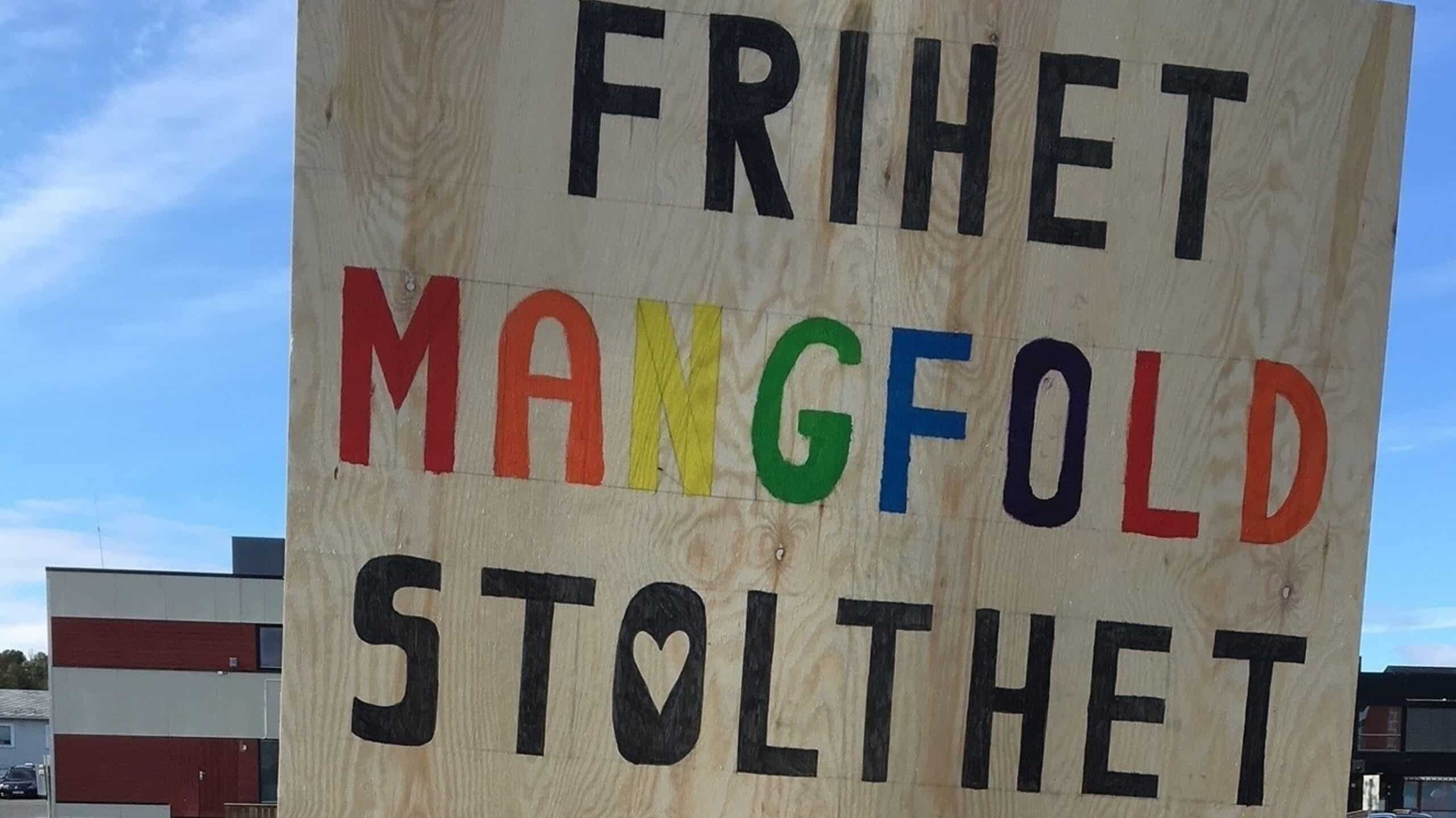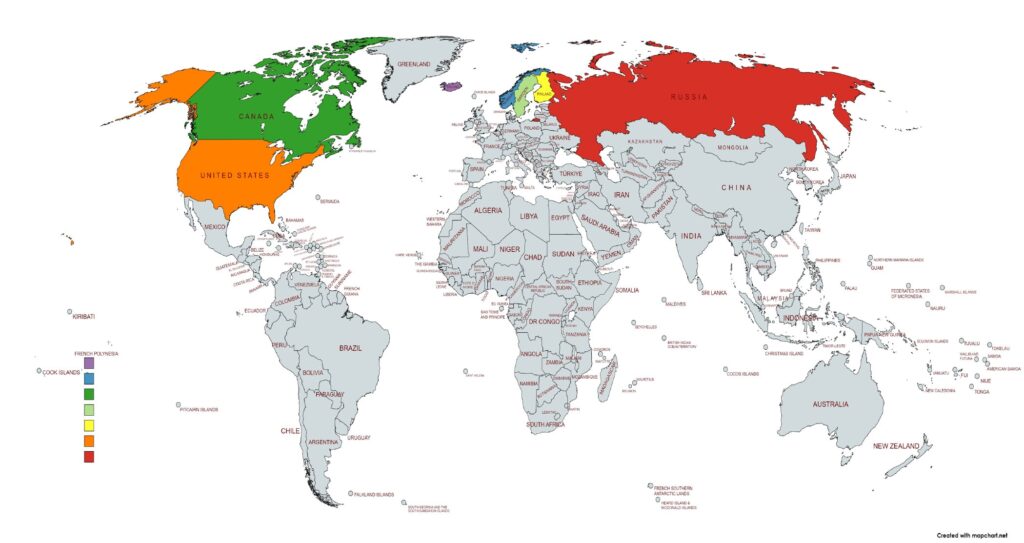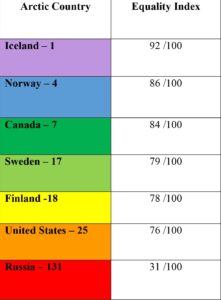Mapping the Landscape of LGBTQ+ Hope Spots: An Arctic Equality Map

A sign of LGBTQ+ Pride in Alta, Norway. Photo: Jean E. Balestrery
The Arctic Institute Queering the Arctic Series 2023
- The Arctic Institute’s Queering the Arctic Series 2023: Introduction
- Mapping the Landscape of LGBTQ+ Hope Spots: An Arctic Equality Map
- Tromsø as a “Safe Space”: LGBTQ+ Inclusivity through Arts in the Arctic Gateway
- Geographical Problems: Interview with Artist Justin Levesque
- Northern Identities: Rereading Woman of Labrador
- The Arctic Institute’s Queering the Arctic Series 2023: Conclusion
This article provides a high-level analysis regarding the current state of place-based policies in support of LGBTQ+ human rights, or hope spots, in Arctic regions. Throughout the world, the United Nations is visible in its work to promote and protect LGBTQ+ human rights. The policy analysis presented here highlights the following countries with land terrain in Arctic regions: Canada, Greenland, Iceland, Norway, Sweden, Finland, Russia, and the United States. The following question guides this analysis: Which countries in the Arctic are more LGBTQ+ friendly?
Mapping the LGBTQ+ policy landscape across these eight countries in an Arctic Equality Map (see the map below) shows a broad range of support, along a global continuum that ranges from criminalization to celebration. While this analysis does not reflect the entire Arctic political or social landscape for LGBTQ+ people, it does provide a general view regarding the current state of LGBTQ+ equality, or hope spots, and continued advocacy needs.

The Arctic is a hope spot
The Arctic regions are among many regions in the world. Viewing LGBTQ+ friendliness within a global context offers a clearer perspective of the social and political landscape for LGBTQ+ people in Arctic countries. Using the Equality Index by Equaldex,1) LGBTQ+ friendliness can be viewed as a numerical value along a continuum that ranges from 0 to 100, with 0 representing less equality and 100 representing more equality. This numerical value is “to help visualize the legal rights and public attitudes towards LGBTQ+ (lesbian, gay, bisexual, transgender, queer, questioning, intersex…) people in each region.”
The Equality Index is an average of the legal index and public opinion index. The legal index is a numerical calculation of the current legal status for 13 different issues, “ranging from the legal status of homosexuality, same-sex marriage, transgender rights, LGBT discrimination protections, LGBT censorship laws, and more” with each topic weighted differently. The public opinion index is a numerical calculation of public attitudes toward LGBTQ+ people based on survey and poll data from reputable organizations. This index score is based on averaging the results of all data for a particular region.
LGBTQ+ Equality by Global Region
Currently, there are an identified 23 regions comprising the world LGBTQ+ Equality map. Among all these regions, the region of Nordic countries ranks highest – 1st out of 23 regions – on the LGBTQ+ Equality Index with a score of 85 out of 100.2) Notably, four out of five Nordic countries are Arctic countries, which include Iceland, Norway, Sweden, and Finland (noted by asterisk below):
| Nordic Countries – 1 /23 | Nordic Countries – 1 /23 |
|---|---|
| Iceland* | 92/100 |
| Denmark | 88 |
| Norway* | 86 |
| Sweden* | 79 |
| Finland* | 78 |
These four Arctic countries, out of the total eight Arctic countries, are bright hope spots on the world LGBTQ+ Equality map.
In addition to these four Arctic countries – Iceland, Norway, Sweden, and Finland, there are two more Arctic countries identified as bright hope spots on the world LGBTQ+ Equality map. These countries include Canada and the United States. Comprising the North America region, Canada and the United States together are identified as 2nd – following the Nordic countries – out of 23 regions in the world in LGBTQ+ friendliness.
| North America – 2 /23 | Equality Index |
|---|---|
| Canada* | 84/100 |
| United States* | 76 |
Along with the Nordic countries and North America, the world LGBTQ+ Equality map shows Australia, New Zealand “and parts of Europe rank highest in terms of the Equality Index while the Middle East and most of Africa (with the exception of South Africa) rank lowest — both in terms of legal protections and public opinion”.3) Notably, six of eight Arctic countries are among the highest-ranking regions for LGBTQ+ friendliness across the globe.
LGBTQ+ Equality by Country
Currently, there are an identified 197 countries comprising the world LGBTQ+ Equality map. The global continuum of LGBTQ+ friendliness encompasses criminalization on one end to celebration on the other end. Among the eight Arctic countries, six show a high degree of LGBTQ+ friendliness with a positioning toward the celebration end on the global continuum. The Arctic country of Russia, however, presents as an exception with an Equality Index score of 131, thereby showing a lower degree of LGBTQ+ friendliness. Russia is positioned more toward the criminalization, rather than celebration, end on the global continuum. In Russia, while there are no laws against homosexual acts, the country does have repressive laws against “propaganda of homosexuality.”
Russia has demonstrated long-standing antipathy toward the LGBTQ+ community. “The ‘gay propaganda’ law of 2013 in Russia legally institutionalized discrimination against LGBTQ+ people…This law continues to be used as justification for discrimination against LGBTQ+ people in Russia”.4) Initially, this ‘gay propaganda’ law of 2013 in Russia prohibited any positive mention of same-sexuality in the presence of minors, including online, and then in 2022 this prohibition extended to all positive same-sex references in any media, including in the presence of adults in addition to minors.
According to Equaldex,5) LGBTQ+ friendliness among the listing of 193 Arctic countries shows the following ranking among Arctic countries (see the table to the right).
It is noted the Arctic country of Greenland is not listed among the 193 countries because currently this country’s Equality Index is based on legal rights alone, with a legal index of 96 out of 100. While this numerical value is high, it represents partial data only. There is an ongoing effort to collect public opinion data about LGBTQ+ issues in Greenland to help with developing an accurate Equality Index.6)
While there is a global movement away from criminalizing same-sex relations, there are still many countries that criminalize same-sex relations. According to Human Dignity Trust,7) 66 countries have jurisdictions that criminalize LGBTQ+ people. Together, these 66 countries comprise approximately one-third of all countries world-wide.
Arctic Hope Spot: Continued Advocacy
The majority of the Arctic countries are a representative hope spot on the world LGBTQ+ equality map. There is one exception and that is the country of Russia. However, even though Nordic countries and North America rank high on the global continuum of LGBTQ+ friendliness, a closer look at the local policy landscape shows complexity.
In North America, the country of the United States shows this complexity. For example, while the United States is in a region that has an Equality Index ranking second out of 23 regions across the globe, and is a country with an Equality Index ranking 27 on a list of 193 countries, there is currently a national state of emergency for LGBTQ+ Americans.8) This national state of emergency follows an unprecedented increase in anti-LGBTQ+ legislative bills being introduced to state legislatures across the country, with many signed into state law. In 2023 alone, more than 725 bills were introduced to state legislatures with more than 75 signed into law so far.9)
Among these anti-LGBTQ+ legislative bills, many are attacks on transgender health care. More specifically, these attacks include legislative bans on medically necessary health care for transgender youth, and it is noted that while many states to date have enacted these laws these laws did not exist before 2021. These Anti-LGBTQ+ laws are structural barriers in healthcare, or health inequities, and a context of “compounded colonization”10) among American Indian and Alaska Native LGBTQ+ peoples or Two-Spirit peoples. In response to these anti-LGBTQ+ legislative attacks, there are positive developments such as states enacting “shield laws” to protect both providers and service recipients in accessing gender affirming care.
While the United States is an Arctic country, there is only one state however with land terrain in the Arctic circle: Alaska. A high-level perspective of the United States shows Alaska with a positioning toward the low end of LGBTQ+ friendliness. Within context of a LGBTQ+ friendliness continuum that ranges from negative, low, fair, medium, and high, Alaska ranks among the bottom half of all United States.11)
In Alaska, all of the United States and the Arctic countries, policy advocacy for LGBTQ+ peoples continues. Such advocacy aims to advance equity, including health equity, to support overall well-being and quality of life for LGBTQ+ peoples. Among LGBTQ+ peoples in the Arctic, elements of strength and struggle are evident12) While the Arctic is a representative hope spot on the world LGBTQ+ Equality map, the complex landscape within Arctic countries shows need for continue policy advocacy to achieve equity. Being visible, celebrating who one is and who one loves are foundational to this continued policy advocacy for LGBTQ+ peoples.
Dr. Jean E. Balestrery is Founder and CEO of Integrated Care Counsel, LLC, a consultancy advancing integrated care in the health and well-being industry; Spirit of Eagles Hampton Faculty Fellow; Licensed Independent Behavioral Health Clinician. The author has multiple affiliations including Founder and CEO of a private entity (consultancy), Spirit of Eagles Hampton Faculty Fellow and employment as a Licensed Independent Behavioral Health Clinician. The author received no support, financial or otherwise, from any affiliation for the research, authorship, and/or publication of this article.
References
